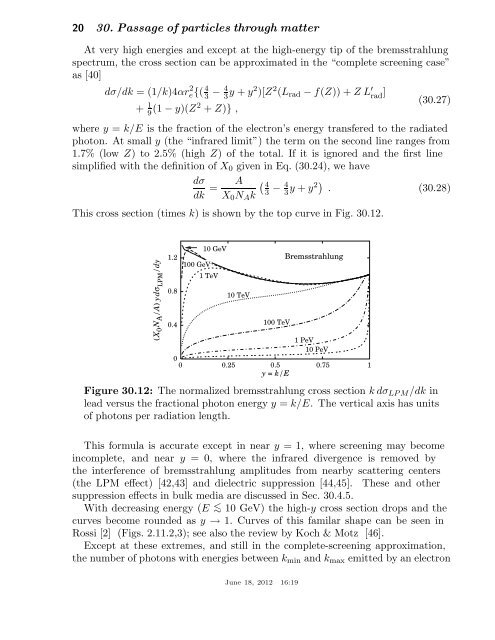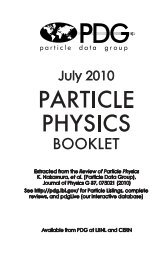30. Passage of particles through matter 1 - Particle Data Group
30. Passage of particles through matter 1 - Particle Data Group
30. Passage of particles through matter 1 - Particle Data Group
You also want an ePaper? Increase the reach of your titles
YUMPU automatically turns print PDFs into web optimized ePapers that Google loves.
20 <strong>30.</strong> <strong>Passage</strong> <strong>of</strong> <strong>particles</strong> <strong>through</strong> <strong>matter</strong><br />
At very high energies and except at the high-energy tip <strong>of</strong> the bremsstrahlung<br />
spectrum, the cross section can be approximated in the “complete screening case”<br />
as [40]<br />
dσ/dk = (1/k)4αr 2 e{( 4 4<br />
3 − 3y + y2 )[Z2 (Lrad − f(Z)) + Z L ′ rad ]<br />
+ 1<br />
9 (1 − y)(Z2 + Z)} ,<br />
(<strong>30.</strong>27)<br />
where y = k/E is the fraction <strong>of</strong> the electron’s energy transfered to the radiated<br />
photon. At small y (the “infrared limit”) the term on the second line ranges from<br />
1.7% (low Z) to 2.5% (high Z) <strong>of</strong> the total. If it is ignored and the first line<br />
simplified with the definition <strong>of</strong> X0 given in Eq. (<strong>30.</strong>24), we have<br />
dσ<br />
dk =<br />
A<br />
X0NAk<br />
�<br />
4 4<br />
3 − 3y + y2� . (<strong>30.</strong>28)<br />
This cross section (times k) is shown by the top curve in Fig. <strong>30.</strong>12.<br />
(X 0 N A /A) ydσ LPM /dy<br />
1.2<br />
0.8<br />
0.4<br />
0<br />
100 GeV<br />
10 GeV<br />
1 TeV<br />
10 TeV<br />
100 TeV<br />
Bremsstrahlung<br />
1 PeV<br />
10 PeV<br />
0 0.25 0.5 0.75 1<br />
y = k/E<br />
Figure <strong>30.</strong>12: The normalized bremsstrahlung cross section k dσLPM/dk in<br />
lead versus the fractional photon energy y = k/E. The vertical axis has units<br />
<strong>of</strong> photons per radiation length.<br />
This formula is accurate except in near y = 1, where screening may become<br />
incomplete, and near y = 0, where the infrared divergence is removed by<br />
the interference <strong>of</strong> bremsstrahlung amplitudes from nearby scattering centers<br />
(the LPM effect) [42,43] and dielectric suppression [44,45]. These and other<br />
suppression effects in bulk media are discussed in Sec. <strong>30.</strong>4.5.<br />
With decreasing energy (E < ∼ 10 GeV) the high-y cross section drops and the<br />
curves become rounded as y → 1. Curves <strong>of</strong> this familar shape can be seen in<br />
Rossi [2] (Figs. 2.11.2,3); see also the review by Koch & Motz [46].<br />
Except at these extremes, and still in the complete-screening approximation,<br />
the number <strong>of</strong> photons with energies between kmin and kmax emitted by an electron<br />
June 18, 2012 16:19







